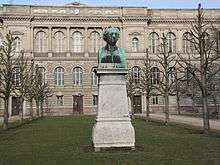Palais Universitaire, Strasbourg
.jpg)
The Palais Universitaire in Strasbourg is a large, neo-Renaissance style building, constructed between 1879 and 1884 under the direction of the German architect Otto Warth. It was inaugurated in 1884 by Wilhelm I, Emperor of Germany. Through Avenue de la Liberté (former Kaiser-Wilhelm-Straße), it faces the equally monumental former imperial palace (Kaiserpalast).
The building served for several decades as the centre of the new imperial University of Strasbourg. The old university transferred from the buildings that it had occupied for centuries at the Jean Sturm Gymnasium to the new ones located in the Neustadt.
Italianate features
The architect, Otto Warth (1845–1918), from Karlsruhe, was young when he was entrusted with the design of the building. He had just returned from a one-year study visit to Italy, and his passion for Italian classical architecture is reflected in some of the Italianate features of the Palais. [1]
The Aula
One of the most distinctive features of the building is the Aula, which measures 25 m by 29 m and 16 m high, which Warth modeled on the Villa Garzoni in Pontecasale, Candiana. [1] It is decorated with a monumental seated statue of Ramses II, 2.15 m (7 ft 1 in) high, brought in 1933 by Pierre Montet.[2]
In 2012, the Aula was dedicated to Marc Bloch, former professor at the university, shot by the Nazis in 1944. [3]
Statuary
The Palais is striking for the statuary of its façades, which pay hommage to a number of scientists, theologians, theoricians and thinkers with Germanic connections, thirty-six in all, including Luther, Leibniz, Calvin, Kepler, Kant, Spener, Lessing, Gauss. [4] Two allegorical statues representing Germania (Germany) and Argentina (Strasbourg), the former removed in 1918 and the latter destroyed in 1945, were replaced in their respective niche on the façade in 2014, after having been restored and/or replicated based on photos.[5]
Monument historique
On 21 May 1990, the hall, the Aula and the main stairways were classified as a monument historique.[6]
Council of Europe
The Parliamentary Assembly of the Council of Europe held its first session in this building, from 8 August to 10 September 1949. [7] [8]
University Press
The Presses Universitaires de Strasbourg, reputedly the oldest university press in France, has had its headquarters in the building ever since it was founded in 1920.
Gypsothèque
The Palace's basement houses the Gypsothèque de Strasbourg, also known as Musée des moulages (plaster cast museum). This classical cast collection was initiated with the founding of the Kaiser-Wilhelms-Universität in 1872 by Adolf Michaelis, a distinguished classical scholar and art history pioneer. Next to casts of works like Harmodius and Aristogeiton, Apollo Belvedere, Aphrodite of Cnidus and the metopes of the Parthenon, the museum also displays casts of works by Antoine Bourdelle. The collection is the second largest cast collection in France and the largest university cast collection of France. The collections were moved into the Palace's basement in 1939, with the outbreak of World War II, and have stayed there since, although plans have periodically been made to move them into a separate building.[9][10]
Gallery
- The Palace's motto on top of the avant-corps
.jpg) Statues of Ramses II in the Grand hall
Statues of Ramses II in the Grand hall.jpg) World War II commemorative plaque inside the Palace
World War II commemorative plaque inside the Palace.jpg) Four of the statues of great learned men on the façade (to read the names, click on the picture)
Four of the statues of great learned men on the façade (to read the names, click on the picture).jpg) Four others
Four others.jpg) Three others
Three others.jpg) Inside the Gypsothèque below the Palace
Inside the Gypsothèque below the Palace.jpg) Inside the Gypsothèque below the Palace
Inside the Gypsothèque below the Palace
References
- 1 2 François Loyer (1991). "Le palais universitaire de Strasbourg : culture et politique au XIXe siècle en Alsace". Revue de l'art. Retrieved 2013-11-29.
- ↑ Statue de Ramsès II on archi-strasbourg.org (French)
- ↑ "Strasbourg dédie l'aula du Palais U à Marc Bloch". L'Alsace. 2012-11-26. Retrieved 2013-11-29.
- ↑ Marie Noëlle Denis (2005). "Les statues de l'Université impériale de Strasbourg et la pédagogie du pangermanisme" (PDF). Revue des Sciences Sociales. Retrieved 2013-11-28.
- ↑ Claire Peyrot (2014). "Strasbourg : le Palais universitaire a 130 ans". France 3 Alsace. Retrieved 2015-05-10.
- ↑ Palais Universitaire on the Mérimée database of the French Ministry of Culture (French)
- ↑ "Palais Universitaire de Strasbourg". JDS - Le Journal des Spectacles. Retrieved 2013-11-28.
- ↑ "The European Vocation of Strasbourg". Centre d'Information sur les Institutions Européennes. Retrieved 2013-11-28.
- ↑ Gypsothèque de Strasbourg, misha1.u-strasbg.fr (French)
- ↑ …sur la Gypsothèque de l’Université de Strasbourg, collections.u-strasbg.fr (French)
External links
 Media related to Palais universitaire de Strasbourg at Wikimedia Commons
Media related to Palais universitaire de Strasbourg at Wikimedia Commons- Palais Universitaire on archi-strasbourg.org (French)
- Strasbourg University Press
Coordinates: 48°35′05″N 7°45′45″E / 48.5848°N 7.7625°E
